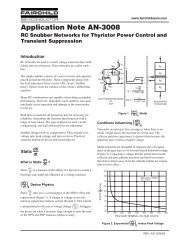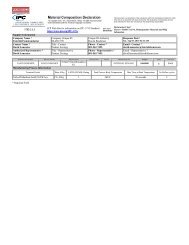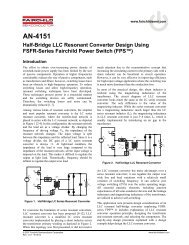AN-9044 - Fairchild Semiconductor
AN-9044 - Fairchild Semiconductor
AN-9044 - Fairchild Semiconductor
You also want an ePaper? Increase the reach of your titles
YUMPU automatically turns print PDFs into web optimized ePapers that Google loves.
9. Power Loss and Dissipation<br />
9.1 Power Loss of SPM<br />
Mini DIP (SPM3) Application Note (2012-07-09)<br />
The total power losses in the Mini DIP SPM are composed of conduction and switching losses in the<br />
IGBTs and FRDs. The loss during the turn-off steady state can be ignored because it is very small amount<br />
and has little effect on increasing the temperature in the device. The conduction loss depends on the dc<br />
electrical characteristics of the device i.e. saturation voltage. Therefore, it is a function of the conduction<br />
current and the device’s junction temperature. On the other hand the switching loss is determined by the<br />
dynamic characteristics like turn-on/off time and over-voltage/current. Hence, in order to obtain the accurate<br />
switching loss, we should consider the DC-link voltage of the system, the applied switching frequency and<br />
the power circuit layout in addition to the current and temperature.<br />
In this chapter, based on a PWM-inverter system for motor control applications, detailed equations are<br />
shown to calculate both losses of the Mini DIP SPM. They are for the case that 3-phase continuous<br />
sinusoidal PWM is adopted. For other cases like 3-phase discontinuous PWMs, please refer to the paper<br />
"Minimum-Loss Strategy for three-Phase PWM Rectifier, IEEE Transactions on Industrial Electronics, Vol. 46,<br />
No. 3, June, 1999 by Dae-Woong Chung and Seung-Ki Sul”.<br />
9.1.1 Conduction Loss<br />
The typical characteristics of forward drop voltage are approximated by the following linear equation<br />
for the IGBT and the diode, respectively.<br />
v<br />
v<br />
I<br />
D<br />
VI<br />
RI<br />
i<br />
V R i<br />
D<br />
D<br />
VI = Threshold voltage of IGBT VD = Threshold voltage of diode<br />
RI = on-state slope resistance of IGBT RD = on-state slope resistance of diode<br />
Assuming that the switching frequency is high, the output current of the PWM-inverter can be assumed<br />
to be sinusoidal. That is,<br />
i I peak cos( )<br />
(9.2)<br />
Where is the phase-angle difference between output voltage and current. Using equations (9.1), the<br />
© 2008 FAIRCHILD SEMICONDUCTOR - Smart Power Module<br />
42<br />
(9.1)







